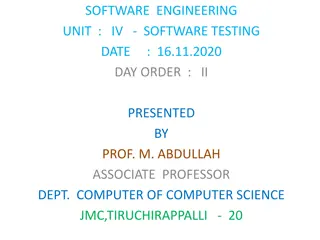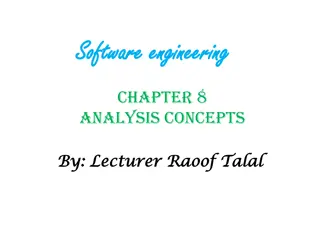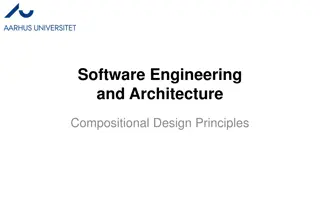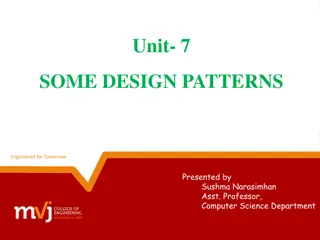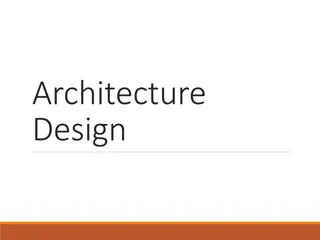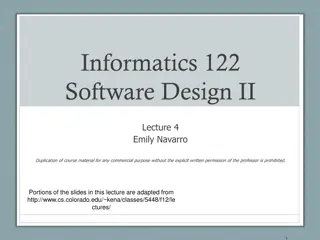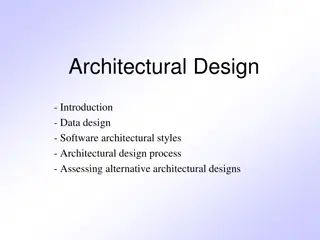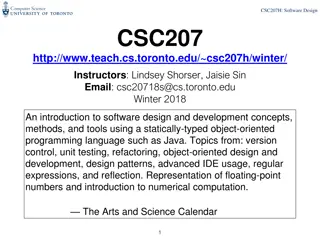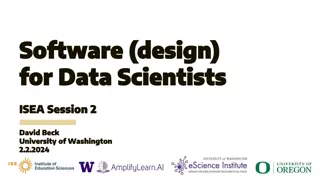Understanding Software Requirements and Design Principles
Software requirements play a crucial role in defining what a system should do, while the design describes how it achieves those goals. This lecture series covers the concepts of user and system requirements, techniques for describing system requirements, organizing software requirements in a document, system models, and the interplay between requirements and design in software engineering. User, system, and software requirements are dissected, emphasizing the need for secure mechanisms, compliance with standards, and domain-specific design considerations in software development.
- Software Requirements
- Design Principles
- System Specifications
- Software Engineering
- User Requirements
Download Presentation

Please find below an Image/Link to download the presentation.
The content on the website is provided AS IS for your information and personal use only. It may not be sold, licensed, or shared on other websites without obtaining consent from the author. Download presentation by click this link. If you encounter any issues during the download, it is possible that the publisher has removed the file from their server.
E N D
Presentation Transcript
Lecturer: Sebastian Coope Ashton Building, Room G.18 E-mail: coopes@liverpool.ac.uk COMP 201 web-page: http://www.csc.liv.ac.uk/~coopes/comp201 Lecture 5 Software Requirements COMP201 - Software Engineering 1
Software Requirements Descriptions and specifications of a system Last time: Introduce the concepts of user and system requirements Described functional /non-functionalrequirements This lecture: To explain two techniques for describing system requirements To explain how software requirements may be organised in a requirements document COMP201 - Software Engineering 2
System Requirements System Requirements are more detailed specifications of user requirements: They serve as a basis for designing the system; may be used as part of the system contract; may be expressed using system models (will be discussed more later). COMP201 - Software Engineering 3
Requirements and Design In principle, requirements should state what the system should do and the design should describe how it does this In practice, requirements and design are inseparable A system architecture may be designed to structure the requirements The system may inter-operate with other systems that generate design requirements The use of a specific design may be a domain requirement COMP201 - Software Engineering 4
User Requirements System Requirements Software requirements Software Design The system will have a secure login (User requirement) The system must provide a secure mechanism to allow a user to deal with the issue of forgotten or compromised passwords (User requirements) The system will have a secure login which complies with NIST Special Publication 800-63-1 authentication guidelines (System Requirement) The system must use only allow 3 attempts and login before locking the user out (Software Requirement) There is a class called Login, which will generically handle the login attempt regardless of the underlying authentication mechanism? COMP201 - Software Engineering 5
Problems with Natural Language Specification Ambiguity The readers and writers of the requirement must interpret the same words in the same way. Natural Language is ambiguous so this is very difficult Over-flexibility The same thing may be said in a number of different ways in the specification which can lead to confusion Lack of modularisation Natural language structures are inadequate to structure system requirements COMP201 - Software Engineering 6
An Example Imagine the following example of an informal specification from a critical system [1] : The message must be triplicated. The three copies must be forwarded through three different physical channels. The receiver accepts the message on the basis of a two-out-of-three voting policy. Questions: Can you identify any ambiguities in this specification? We will later see some other ways with documenting this example by a Petri net (see Lecture 9). [1] - C. Ghezzi, M. Jazayeri, D. Mandrioli, Fundamentals of Software Engineering , Prentice Hall, Second Edition, page 196 - 198 7
Alternatives to NL Specification Notation Description Structured natural language Design description languages requirements by defining an operational model of the system. Graphical notations used to define the functional requirements for the system. An early example of such a graphical language was SADT (Ross, 1977; Schoman and Ross, 1977). More recently, use-case descriptions (Jacobsen, Christerson et al., 1993) have been used. I discuss these in the following chapter. Mathematical specifications such as finite-state machines or sets. These unambiguous specifications reduce the arguments between customer and contractor about system functionality. However, most customers don t understand formal specifications and are reluctant to accept it as a system contract. I discuss formal specification in Chapter 9. This approach depends on defining standard forms or templates to express the requirements specification. This approach uses a language like a programming language but with more abstract features to specify the A graphical language, supplemented by text annotations is These are notations based on mathematical concepts COMP201 - Software Engineering 8
Structured Language Specifications A limited form of natural language may be used to express requirements This removes some of the problems resulting from ambiguity and flexibility and imposes a degree of uniformity on a specification Special-purpose forms where designed to describe the input, output and functions of a software system Often best supported using a forms-based approach COMP201 - Software Engineering 9
Forms Define the information required Constrain its format Keeps the information in a defined structure Filter out extra information that might cause confusion Makes it possible to read specification quickly Supports tasks like system testing COMP201 - Software Engineering 10
Form-Based Specifications Definition of the function or entity Description of inputs and where they come from Description of outputs and where they go to Indication of other entities required Pre and post conditions (if appropriate) The side effects (if any) COMP201 - Software Engineering 11
Form-Based Specification Example Insulin Pump/Control Software/SRS/3.3.2 Function Compute insulin dose: Safe sugar level Description Computes the dose of insulin to be delivered when the current measured sugar level is in the safe zone between 3 and 7 units. Inputs Current sugar reading (r2), the previous two readings (r0 and r1) Source Current sugar reading from sensor. Other readings from memory. Outputs CompDose the dose in insulin to be delivered Destination Main control loop Action: CompDose is zero if the sugar level is stable or falling or if the level is increasing but the rate of increase is decreasing. If the level is increasing and the rate of increase is increasing, then CompDose is computed by dividing the difference between the current sugar level and the previous level by 4 and rounding the result. If the result, is rounded to zero then CompDose is set to the minimum dose that can be delivered. Requires Two previous readings so that the rate of change of sugar level can be computed. Pre-condition The insulin reservoir contains at least the maximum allowed single dose of insulin.. Post-condition r0 is replaced by r1 then r1 is replaced by r2 Side-effects None COMP201 - Software Engineering 12
Forms and incompleteness Forms help to check for incompleteness Example.. You could add the following Does function have implications for data protection act? Is the function compliant with 35.240.80: IT applications in health care technology? Is this function time constrained and if those what are the constraints? What other modules does this function need to perform it s task? COMP201 - Software Engineering 13
Tabular Specification Tabular Specification is used to supplement natural language. It is particularly useful when you have to define a number of possible alternative courses of action This can be thought of as a series of if statements to determine the action to be taken upon a certain criteria being met. COMP201 - Software Engineering 14
Tabular Specification Example Condition Action Sugar level falling (r2 < r1) CompDose = 0 Sugar level stable (r2 = r1) CompDose = 0 Sugar level increasing and rate of increase decreasing ((r2-r1)<(r1-r0)) CompDose = 0 Sugar level increasing and rate of increase stable or increasing. ((r2-r1) (r1-r0)) CompDose = round ((r2-r1)/4) If rounded result = 0 then CompDose = MinimumDose COMP201 - Software Engineering 15
PDL-Based Requirements Definition Program Design Language - Requirements may be defined operationally using a language like a programming language but with more flexibility of expression Most appropriate in the following situations: Where an operation is specified as a sequence of actions and the order is important When hardware and software interfaces have to be specified Disadvantages include: The PDL may not be sufficiently expressive to define domain concepts The specification will be taken as a design rather than a specification (lead to non optimal solution) COMP201 - Software Engineering 16
Part of an ATM Specification set try_count to 0 Do while PIN not equal to stored PIN Get PIN from customer If PIN doesn t equal stored PIN then increment try_count If try_count equals to maximum tries retain card and quit transaction with error message End Do COMP201 - Software Engineering 17
Interface Specification Most systems must operate with existing systems and the operating interfaces must be precisely specified as part of the requirements Three types of interface may have to be defined Procedural interfaces (calling methods) Data structures that are exchanged (XML schema) Data representations (UNICODE, ASCII etc.) Formal notations are an effective technique for interface specification but their specialised nature means they are difficult to understand without special training. COMP201 - Software Engineering 18
Example - Interface Description interface PrintServer { // defines an abstract printer server // requires:interface Printer, interface PrintDoc // provides: initialize, print, displayPrintQueue, cancelPrintJob, switchPrinter void initialize ( Printer p ) ; void print ( Printer p, PrintDoc d ) ; void displayPrintQueue ( Printer p ) ; void cancelPrintJob (Printer p, PrintDoc d) ; void switchPrinter (Printer p1, Printer p2, PrintDoc d) ; } //PrintServer Note this is supported in Java allowing you to use the design to constrain the code COMP201 - Software Engineering 19
The Requirements Document The software requirements document is the official statement of what is required of the system developers Should include both a definition and a specification of requirements It is NOT a design document. As far as possible, it should set of WHAT the system should do rather than HOW it should do it The requirements document has a diverse set of users as we see in the next slide COMP201 - Software Engineering 20
Specify the requirements and read them to check that they meet their needs. They specify changes to the requirements Users of a Requirements Document System customers Use the requirements document to plan a bid for the system and to plan the system development process Managers Use the requirements to understand what system is to be developed System engineers Use the requirements to develop validation tests for the system System test engineers Use the requirements to help understand the system and the relationships between its parts System maintenance engineers COMP201 - Software Engineering 21
Requirements Document Specify external system behaviour (what does it do?) Specify implementation constraints (what system it must run on, what programming language it must use) Easy to change Serve as reference tool for maintenance Record forethought about the life cycle of the system i.e. predict changes (how can it be expanded for more users) Characterise responses to unexpected events (e.g. what should it do if power is lost!) COMP201 - Software Engineering 22
Requirements Document The level of detail used within the requirements document depends on both the type of system and the development process being used. For an evolutionary development model the requirements may change many times. In the waterfall model however, it should be more complete since this has more impact on later stages of the software design process. If the (sub)-system will be developed by an external contractor or it is a critical system, more time needs to be taken on finalizing the requirements document. COMP201 - Software Engineering 23
Requirements Document Structure example Preface (including change history) Introduction Contents Glossary User requirements definition System architecture System requirements specification System models System evolution (we have 10,000 customers, what happens if we have 100,000,000) Appendices Index COMP201 - Software Engineering 24
Requirements Document Structure Preface Define the expected readers of the document, the version history with a rationale for version changes and a summary of changes. Author list Introduction Describes the need for the system and the functions provided as well as how it interacts with existing systems. Explain how the software fits into the business or strategic objectives of the organisation. Glossary Define technical terms used in the document making no assumptions on the technical expertise of the reader. COMP201 - Software Engineering 25
Requirements Document Structure User requirements definition Describe the services provided for the user and the non-functional requirements of the system using natural language, diagrams understandable by customers. Define any product and process standards. System architecture High-level overview of the system architecture showing the distribution of functions across system modules. System requirements specification Detailed description of the functional and non-functional requirements. COMP201 - Software Engineering 26
Requirements Document Structure System models Define system models showing relationships between system components, the system and its environment (object, data-flow models etc.) System evolution Describe anticipated changes to the system due to hardware evolution and changing user requirements etc. Appendices Detailed specific information about the system being developed such as hardware and database descriptions. Index Indices of the document including diagrams and functions. COMP201 - Software Engineering 27
Key Points Requirements set out what the system should do and define constraints on its operation and implementation Functional requirements set out services the system should provide Non-functional requirements constrain the system being developed or the development process User requirements are high-level statements of what the system should do COMP201 - Software Engineering 28
Key Points User requirements should be written in natural language, tables and diagrams System requirements are intended to communicate the functions that the system should provide System requirements may be written in structured natural language, a PDL or in a formal language A software requirements document is an agreed statement of the system requirements COMP201 - Software Engineering 29
Next Lecture We shall be looking in more detail at requirements engineering processes and way in which we can elicit, analyse, validate and maintain our requirements. COMP201 - Software Engineering 30





